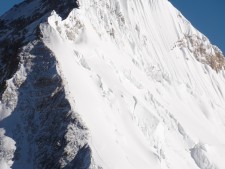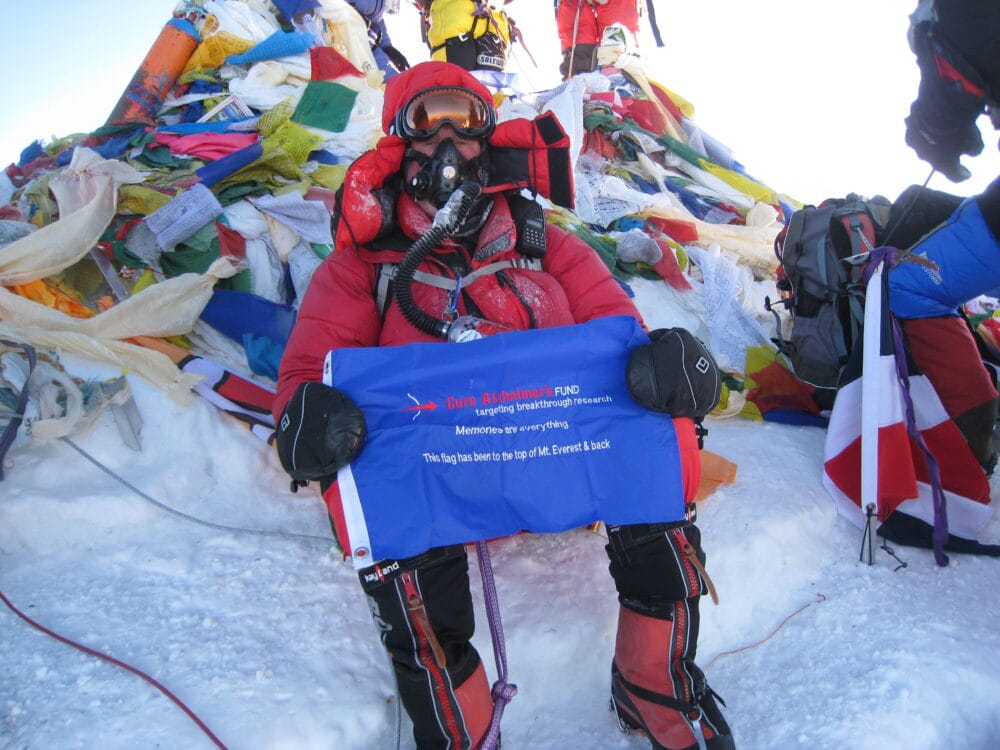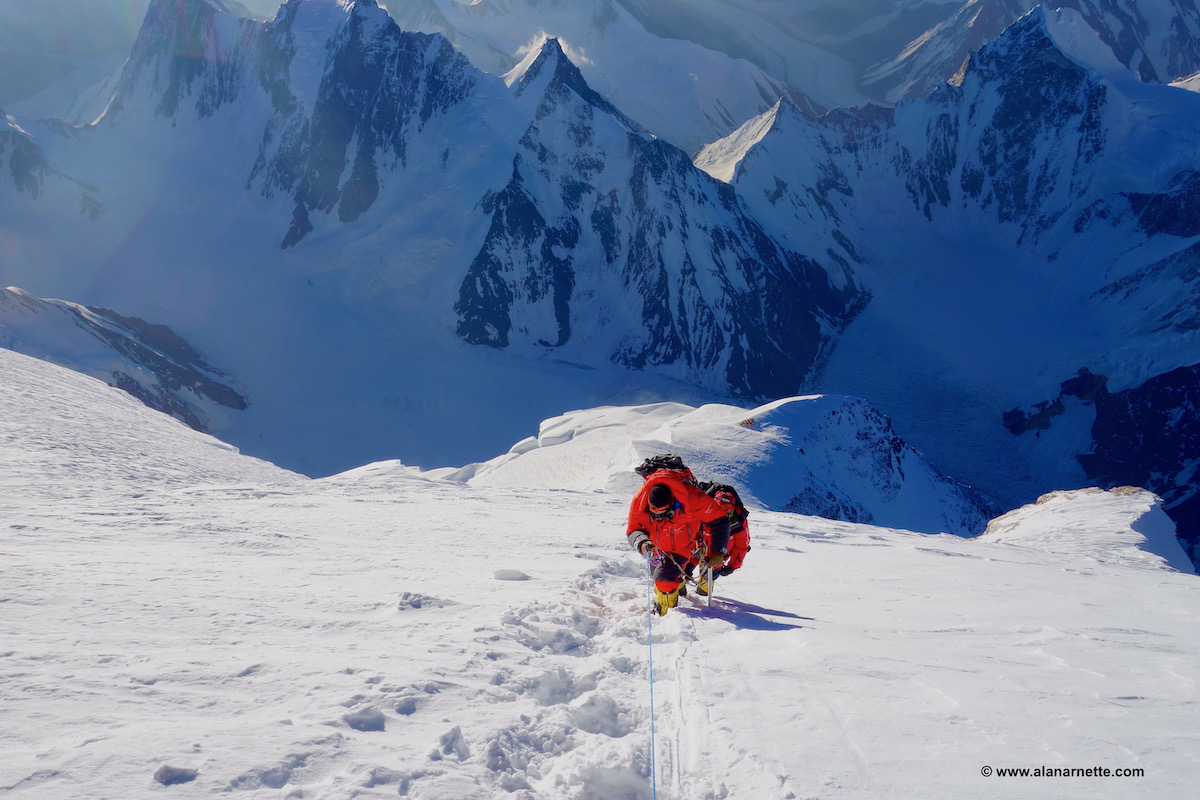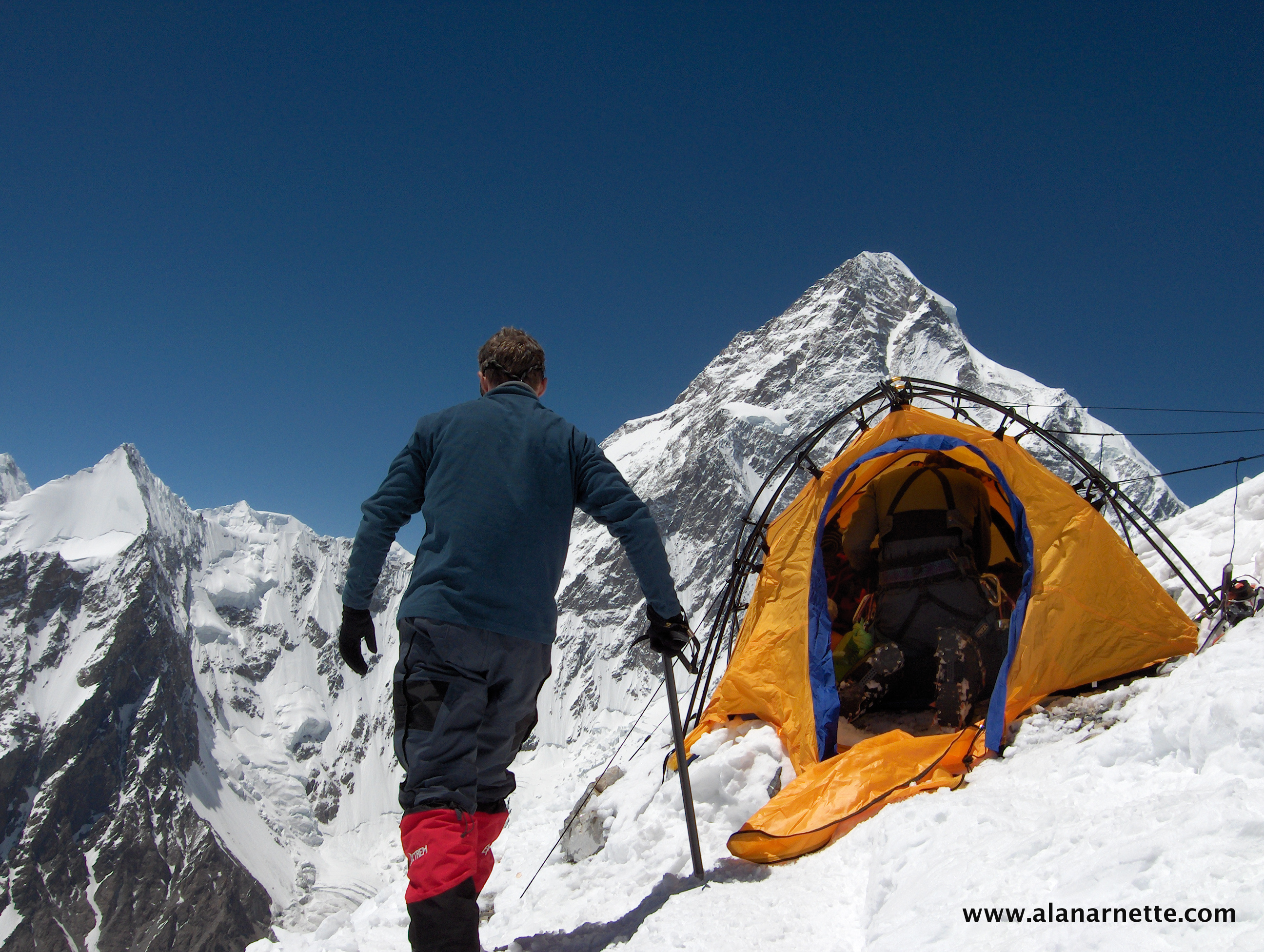Taking some personal liberty during this Everest 2024 season coverage, I want to share my 2011 Everest summit with an overview, narrative and Podcast. I hope you enjoy it.
On May 21, 2011, I stood one step below Mt. Everest’s summit along with Kami Sherpa. It was my fourth try. My three “non-summits” were not failures; they were learning experiences. But I knew something had to change if I wanted this.
I looked at my “why” and shifted from climbing for me to climbing to honor Ida Arnette and raise research money for Alzheimer’s nonprofits.
Standing at 29,030 feet, Kami let out the familiar celebratory cry of “Suummmiiiiit.” I hugged him, my teammates Miriam and Karim and others. I radioed IMG’s base camp managers, Greg Vernovage and Ang Jangbu Sherpa, to thank them for supporting us throughout the expedition. From my satellite phone, I called home.
Then I sat on the snow, pulled my down hood over my face, choking up with my throat tightening and gulped the thin air as tears streamed down my red, cold cheeks. My thoughts drifted to the last conversation with Mom before I went to Everest in 2008. She thought I had already gone and come back. “So how’d you do? Doesnt matter, I just hope you got this out of your system.” She giggled as she often told me this after each climb. Sorry Mom, never did, and never will.
After a few moments, I lifted my head and pushed the hood back. The sun was rising over Bhutan, creating the shadow of Chomolungma that spread across the Himalayas, protecting her western flanks. Soon, a soft glow lit the countless towering peaks that dominated the view in every direction.
My feelings navigated the rapids of joy, gratitude, humility, sadness and peace. You see, this was not only a summit; it was for something larger than myself, a greater purpose, and a reason that was and remains deeply meaningful and motivating.
Mountains are not conquered; they should be treated with respect. Climbing is a gift, not a right, and for someone like me, you don’t go alone; you go with generous souls who understand the greater meaning.
Thirteen years later, my climbing passion has been tamed by time, but I give back as I can. For those who celebrate this month, be it a graduation, a birth, a new beginning or perhaps a quiet mountain top, I say well done. Take the moment and let it change you to be a better version of yourself.
Climb On!
Alan
Memories are Everything
Alan Arnette’s Trip Report written the day after I summited, May 22, 2011
Everest Summit Recap – more than a summit

I stood on the summit of Mount Everest at 5:00 AM, Monday, May 21, 2011. To say this event had a personal meaning is an understatement. To say it had a broader meaning leaves much to be explained. I will write a complete trip report to my usual standard once I get home, but here is an overview of my summit push for now.
The weather played havoc with every team in 2011. High winds were forecasted and changed plans, but then they never materialized. Sudden storms appeared without notice, causing great discomfort, concern and, in some cases, frostbite and blindness. So when our IMG expedition leader announced at 9:00 PM May 15 that the weather forecast had changed for the positive and that we needed to leave base camp in 5 hours, we were skeptical, to say the least.
But we moved ahead, spending a night at Camp 1 and then to Camp 2. But the forecast changed again, this time calling for high winds the morning of May 19, we were supposed to summit. While other teams ignored this revision, we stood down and spent another night at Camp 2. It was not all bad since this gave our bodies more time to rest, hydrate and prepare for our ultimate summit push. But now our summit was at the end of a 3-day window of low winds, so the margin for error was reduced to zero – assuming the forecast was valid.
But we moved to Camp 3, then to the South Col, a harsh camp at nearly 8000m where the body no longer functions properly. My climb from C3 to the Col was over twice as fast as my previous climb, about 3 hours. The recent snows had made the route over the Yellow Band, a limestone strata that crosses the Himalayas in the area, and on the Geneva Spur slightly easier than climbing on rock.
Arriving at the South Col is more like landing on a distant planet. The ground is covered with small slate tablets revealing a history of being underwater at some point – amazing. But the overriding feature is the route up the Triangular Face to the Balcony. From there, the route follows the Southeast ridge to the South Summit. You cannot see the true summit of Everest from the South Col – but you know it is there.
As we settled into our tents at 9:00 AM, we knew we would leave about 12 hours later, weather-dependent. Then the call came: the winds, which had been forecasted to be calm, were now called to pick up in the afternoon and then die down in the night when we were climbing. But more unsettling was that extremely high winds were called for the next day—after our summit. The tension mounted as our window became much shorter.
The winds started up Friday afternoon on schedule. That same morning, we heard of over 100 summits with perfect conditions. I was tenting with Mirjam, and we just lay in our sleeping bags, trying to sleep. My overriding thoughts were of the winds and if they did not stop. IMG was not set up for us to stay at the Col for another day. After two months of preparation, it could all come to an end.
But as the sun set, the winds seemed to calm. At this point, there were less than 30 people at the South Col, meaning crowds would not be a huge issue. We set a departure time of 9:00 PM. My personal thought was that it would take me between 12 to 14 hours to reach the summit, at my pace, putting me there at midday on May 21. I lay in my tent, my stomach churning; I was getting more and more nervous with each passing gust.
The summit meant a lot to me, given I had tried three times. I had prioritized climbing and found great satisfaction from the expedition life to meeting fellow climbers to climbing. Yet, Everest remained a goal far beyond my skills and ability. I had climbed just below the Balcony in each previous attempt, turning back due to not being physically or mentally strong enough.
But Alzheimer’s changed my life forever. As my mom spent eight difficult years with the disease, I saw the lack of knowledge in the public, the lack of funding for research, and the lack of tools for the disease. More was needed, and there was no tomorrow for Alzheimer’s. Outstanding non-profits existed, but I wanted to be aggressive with my mission of fundraising, awareness building and education thus, combining it with my climbing, I felt I could reach people who otherwise missed or did not have an outlet for their personal stories. In the 60 days I would take to climb Everest, 74,057 would be diagnosed with Alzheimer’s just in the US.
The 7 Summits Climb for Alzheimer’s: Memories are Everything was born with the support of Janssen AI and Pfizer. I reached the top of Vinson in Antarctica and Aconcagua in South America and now was laying in a -20F sleeping bag at 26,400′ in gale force winds. My supporters had made it clear that safety was the top priority; however, I knew that if I did not summit Everest, the underlying premise of my 7 Summits mission would be damaged. After all, who got the bronze medal in the 100-meter sprint in the last Olympics?
As the winds dyed, I filled my thermos with hot water and turned on the batteries for my foot warmers. I put hand warmers in my gloves, pulled on my wool cap, positioned my goggles around my down hood and stepped out of the tent and onto the South Col. In the total darkness, the stars showed brightly between the strong gusts.
At this point, we were a team of fourteen, seven members and seven Sherpas. With full-down suits, oxygen bottles in every pack, and headlamps on, we left the South Col at 9:20 PM on May 20. My heart pounded. I felt the pressure. I felt the strength. The comments on my website had been a source of continuous encouragement not only for the climb but, more importantly, for the cause. I felt the strength of a million legs.
The climb from the South Col to the Balcony starts steep and continues. A fixed line was already in place, as set by a team of Sherpas a few weeks earlier. As the wind gusted, I put my goggles on, but the moisture from my oxygen mask created fog or condensation, thus obscuring my view. Why didn’t I use the small fan for my goggles?
We started at a reasonable pace, and I was shocked to find Kami and me passing people standing in place with 1000-yard stares, not that I could see their eyes. I climbed steadily, putting every thought of my past experience out of my mind—but then embraced them as lessons and put them into real practice. I focused on my breathing—steady, not gasping. I diligently placed my foot, taking advantage of every footprint in the soft snow.
I practiced my mantra: 1 step, then a second, take a third; consider where I was and why while taking a few extra breaths – and start over.
The climb to the Balcony was long, longer than I remember. The winds had brought new snow up to our calves. Sometimes, a step would take you lower, causing an involuntary gasp that comes with using big muscles in your leg. Our team was on the lead-breaking trail. I followed Kami carefully, knowing that perseverance and patience would pay off. And then we arrived at the Balcony, a snow-covered flat spot the size of a house’s living room. With headlamps aglow, it looked like something out of the movie Close Encounters.
I looked at my watch—we had left at 9:20 PM, and it was now 1:00 AM—3:20 minutes! I had counted on 6 at a minimum. I told Kami, and he just shrugged. It seems that Sherpas have a different time system.
Once again, the Sherpas went into action. Every climber needed a new bottle of supplemental oxygen. That required taking the current one out of the pack, unscrewing the regulator, putting it on the new bottle that a Sherpa had carried, testing it for leaks and putting it back in the pack. More than one climber had an issue with this process, which was not unique to IMG and not unusual, with sub-zero temps, which caused the hard metal moving parts to freeze. But the Sherpas have centuries of collective experience with their five, ten, fifteen respective Everest summits, so they know what to do.
I took a drink while my bottle was being changed. I only had a moment to consider that this was my personal altitude record—it felt good. I looked up at the South Summit, slightly illuminated by the half-moon. It looked high, far away and very steep. I felt nervous. Could I really do this? One step, two, then a third.
The first section seemed doable; it was in fresh snow. I hoped breaking the trail would slow Minga, the Sherpa in the lead, down a bit, but that hope was in vain. I was now fourth in our conga line behind Minga, Mirjam and Kami. How in the world did I end up in this spot?
The route turned not in direction but in slope; the steepness went from 20 to 40 degrees and continued. We continued at a steady pace. I looked around and saw another 8000m mountain silhouetted to the East, Makalu. The other high Himalayan mountains looked like soldiers standing individually and proudly. Stars show brightly in the rarified air void of the contaminates of modern-day life. But my momentary sightseeing came to a quick halt.
As I climbed higher, I knew there was a section known as the slabs below the South Summit, but honestly, I was unprepared for what I encountered. This section of maybe 300 feet was covered with smooth rock, sometimes in 10 to 30-foot uplifts. While there was a fixed rope, the climbing required all my skills. The primary issue was the fogged goggles and the protruding oxygen mask. I could not see my feet or where to step. It was climbing blind, literally.
I would watch Kami climb a section and try to put my feet where he did. But more generally, I would put my front crampon points on a small outcrop of rock and either push with my legs or with my arms to lift me to the next section. I was glad I did this in the dark; sometimes ignorance is bliss.
The slab section ended, but then I saw the South Summit, which required a climb on a relatively simple snow slope; however, the angle was now over 60 degrees, which is steep—one step, two, then a third. Then I saw it.
The true summit of Everest came into view for the first time since I saw it from Pumori a few weeks ago. I took a moment to let it sink in. And I knew I would make it. For the first time in my life, I knew I would stand on the top of the world. The feeling permeated my body. I relaxed and took the cool oxygen deep into my hurting lungs. It felt good.
I down-climbed from the South Summit to a small flat section where we changed my oxygen bottle again—all part of the plan that allowed me to run at a slightly higher rate. Lessons from the past climbs are coming to life now. But a change occurred; the winds went from breezy to gale. I became very cold. My toes told me that something had changed. My body was cold since the early climb had generated a tiny amount of perspiration, and my down suit did not breathe that well, so it was trapped and now conducting cold onto my core. I picked up the pace to generate some heat.
The infamous Cornice Traverse came not sight. A short section of maybe 30 feet but at 2 feet wide with thousand-foot drop-offs on both sides, it is a feared section for many. I am not sure why, but I simply walked across, glancing at that deadly exposure without much thought. My thoughts might have been of the Hillary Step. Rumor had it that it was easier than normal, with a lot of snow making the crampon climbing easier.
We came to the base of the Step and there was snow and a lot of rock. Once again, I climbed blind, in the dark, with only my headlamp showing the way. I was clipped into the fixed line and placed my front points carefully. Oddly, it took only a few moves, and I overcame this feature. Once again, reality was easier than apprehension. But there was a surprise. At the top of the step we had to go left around a chair sized rock, not a big deal but it was on a ledge with another thousand foot drop to west (what would you expect on the highest mountain in the world?) A slip would be deadly, so staying clipped in was critical.
The final section came into view. I was expecting a nice, gentle, groomed blue ski slope, but this was steep and somewhat narrow. But the big picture was incredible. The true summit remained hidden, and the route followed the contours. However, it was the wind-blown cornices that caught my attention. These snow sculptures by never-ending winds created an art gallery worthy of the Getty. Gentle curves like cake icing swirled up and down as we gained altitude.
A low glow was just appearing on the eastern horizon. We were the first on the planet to see this dawn. The winds were now gusting to 40 mph. It was cold, very cold. Then I saw them, prayer flags a bit higher and ahead—the summit of Mount Everest. I looked at my feet, or a bit ahead. Now was not the time to trip. I forgot about the pain in my lungs, sore legs, wind, and insecurities.
With one more step I was standing on the summit of Mount Everest, 29,035 feet, 8850 meters. The summit was small; maybe ten people could squeeze onto it. While we were the first four that day, three climbers from the North were already there. On yeah, there was another side to Everest!
The prayer flags dominated the summit. Incredibly a small bench had been carved out of the snow allowing people to pose for pictures, I took advantage of this seating to simply rest. I was tired, very tired. We had climbed from the South Col to the summit at about 7:40. Not in my wildest dreams…
As the wind howled, my body core dropped. My toes and fingers went from cold to numb. I took out my satellite phone and briefly posted on the blog. I am unsure I could have held it together for too long. I dedicated this summit to my Mom, Ida Arnette, and all the Alzheimer’s moms out there. After the call, I heaved with emotion in the privacy of my down hood.
With the wind howling, Kami took pictures of me and put away my camera, my only regret. He was ready to go, and so was I as I became colder and colder. I looked around. Words or pictures cannot capture the scale of what I saw. In every direction were snow-capped mountains, ice-white glaciers, frozen rivers and stretches of flat expanses, all lit by the predawn sunrise. Despite the winds, a moment of peacefulness filled me, and I took my first steps away from the summit—nine years to get here, ten minutes to stay. While the ratio seems unfair, the memories will last forever.
Retracing our steps, I down climbed the Hillary Step with no serious issues other than my oxygen mask freezing up cause a brief moment of panic when I simply told Kami, “I can’t breath”. A strong beating of the ice formation blocking the intake solved the problem. I honestly don’t remember crossing the Cornice Traverse with its deadly exposure. The climb back up the South Summit was straight forward, but then we saw the crowds climbing up the slabs below the South Summit. It was like a Zombi movie with people climbing in slow motion or not at all; looking at the steep slabs in the light of day caused me to appreciate the cover of darkness.
I was beat, between the pace, the wind, the cold, and the emotions; I was empty. I arrived at the South Col three hours after leaving the summit. I collapsed in a tent, without taking off my boots, into a deep sleep. Kami woke me up an hour later, and we left for a very long down climb to Camp 2. I Lost the distinction between night and day, standing and walking, up and down; my body was on automatic, my mind numb.
Now back in Base Camp, I am preparing for the three-day walk to Lukla, the flight to Kathmandu and back home. It will be good to be home again.
I am sure that as I walk the trails of the Khumbu, the reality of this summit will set in. I will ponder why this time was so different, so fast, why I stood on top of the world. I will think about how to reach more people with the cause, how to thank so many who took the time to send me words, prayers and thoughts of encouragement, and how to let people know that their belief in me made a difference.
I want to bring into focus the need to educate people around the world about Alzheimer’s, how it destroys families, finances, and individuals, how we need more money for research, and how we need that lucky break in the lab. Standing on top of the world was easy in comparison.
But for now, there is reason to celebrate. Goals are meant to be pursued and obtained. Perseverance can be motivating; however, doing something for a larger meaning can make the difference between one step, a second and a third.
Climb On!
Alan
Memories are Everything
Podcasts
Alan remembers his 2011 Everest Summit
You can listen to #everest2024 podcasts on Spotify, Apple Podcast, Breaker, YouTube, Pocket Casts, RadioPublic, Anchor, and more. Just search for “alan arnette” on your favorite podcast platform.
Everyday Everest
A 16-part podcast series during the Everest 2024 climbing season.
Based on my Fictional 2020 Virtual Everest series, I posted a twenty-minute updated episode a few times a week throughout this season. Everyday Everest follows a fictional team of nine climbers and their personal Sherpas from leaving home to trekking to base camp, acclimatizing, and finally, on their summit push. The story’s protagonist, Harper, sets the tone for the story when she tells her husband, Marc, “Honey, I’m going to climb Everest.”
You can listen to Everyday Everest on Spotify, Apple Podcast, Breaker, YouTube, Pocket Casts, RadioPublic, Anchor, and more. Just search for “alan arnette” on your favorite podcast platform.
Previous Everyday Everest Episodes
- Everyday Everest Podcast Part 16–Home and The End
- Everyday Everest Podcast Part 15–Summit!!
- Everyday Everest Podcast Part 14–Summit Push
- Everyday Everest Podcast Part 13–Climbing Above Camp 3
- Everyday Everest Podcast Series Part 12–Summit Plan for the Team
- Everyday Everest Podcast Series Part 11–First Summits
- Everyday Everest Podcast Series Part 10–Climbing the Lhotse Face
- Everyday Everest Podcast Series Part 9–Summit Date Planned
- Everyday Everest Podcast Series Part 8–Suffering at Camp 2
- Everyday Everest Podcast Series Part 7–Into the Cwm
- Everyday Everest Podcast Series Part 6–Into the Icefall
- Everyday Everest Podcast Series Part 5–Arrival At Base Camp
- Everyday Everest Podcast Series Part 4–Blessing in the Khumbu
- Everyday Everest Podcast Series Part 3–The Trek Begins
- Everyday Everest Podcast Series Part 2–Hello Kathmandu
- Everyday Everest Podcast Series Part 1–Welcome and Part 1
Preparing for Everest is more than Training
There are five Summit Coach clients on Everest in 2024
If you dream of climbing mountains but are unsure how to start or reach your next level, from a Colorado 14er to Rainier, Everest, or even K2, we can help. Summit Coach is a consulting service that helps aspiring climbers worldwide achieve their goals through a personalized set of consulting services based on Alan Arnette’s 30 years of high-altitude mountain experience and 30 years as a business executive. Please see our prices and services on the Summit Coach website.





